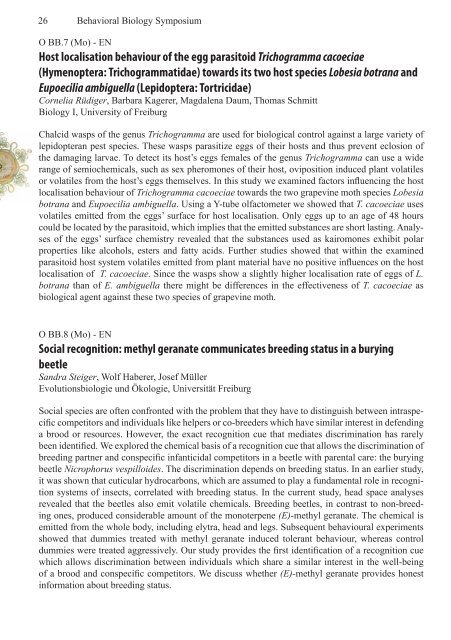Abstracts - Deutsche Zoologische Gesellschaft
Abstracts - Deutsche Zoologische Gesellschaft
Abstracts - Deutsche Zoologische Gesellschaft
You also want an ePaper? Increase the reach of your titles
YUMPU automatically turns print PDFs into web optimized ePapers that Google loves.
26 Behavioral Biology SymposiumO BB.7 (Mo) - ENHost localisation behaviour of the egg parasitoid Trichogramma cacoeciae(Hymenoptera: Trichogrammatidae) towards its two host species Lobesia botrana andEupoecilia ambiguella (Lepidoptera: Tortricidae)Cornelia Rüdiger, Barbara Kagerer, Magdalena Daum, Thomas SchmittBiology I, University of FreiburgChalcid wasps of the genus Trichogramma are used for biological control against a large variety oflepidopteran pest species. These wasps parasitize eggs of their hosts and thus prevent eclosion ofthe damaging larvae. To detect its host’s eggs females of the genus Trichogramma can use a widerange of semiochemicals, such as sex pheromones of their host, oviposition induced plant volatilesor volatiles from the host’s eggs themselves. In this study we examined factors influencing the hostlocalisation behaviour of Trichogramma cacoeciae towards the two grapevine moth species Lobesiabotrana and Eupoecilia ambiguella. Using a Y-tube olfactometer we showed that T. cacoeciae usesvolatiles emitted from the eggs’ surface for host localisation. Only eggs up to an age of 48 hourscould be located by the parasitoid, which implies that the emitted substances are short lasting. Analysesof the eggs’ surface chemistry revealed that the substances used as kairomones exhibit polarproperties like alcohols, esters and fatty acids. Further studies showed that within the examinedparasitoid host system volatiles emitted from plant material have no positive influences on the hostlocalisation of T. cacoeciae. Since the wasps show a slightly higher localisation rate of eggs of L.botrana than of E. ambiguella there might be differences in the effectiveness of T. cacoeciae asbiological agent against these two species of grapevine moth.O BB.8 (Mo) - ENSocial recognition: methyl geranate communicates breeding status in a buryingbeetleSandra Steiger, Wolf Haberer, Josef MüllerEvolutionsbiologie und Ökologie, Universität FreiburgSocial species are often confronted with the problem that they have to distinguish between intraspecificcompetitors and individuals like helpers or co-breeders which have similar interest in defendinga brood or resources. However, the exact recognition cue that mediates discrimination has rarelybeen identified. We explored the chemical basis of a recognition cue that allows the discrimination ofbreeding partner and conspecific infanticidal competitors in a beetle with parental care: the buryingbeetle Nicrophorus vespilloides. The discrimination depends on breeding status. In an earlier study,it was shown that cuticular hydrocarbons, which are assumed to play a fundamental role in recognitionsystems of insects, correlated with breeding status. In the current study, head space analysesrevealed that the beetles also emit volatile chemicals. Breeding beetles, in contrast to non-breedingones, produced considerable amount of the monoterpene (E)-methyl geranate. The chemical isemitted from the whole body, including elytra, head and legs. Subsequent behavioural experimentsshowed that dummies treated with methyl geranate induced tolerant behaviour, whereas controldummies were treated aggressively. Our study provides the first identification of a recognition cuewhich allows discrimination between individuals which share a similar interest in the well-beingof a brood and conspecific competitors. We discuss whether (E)-methyl geranate provides honestinformation about breeding status.

















